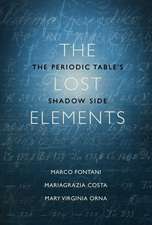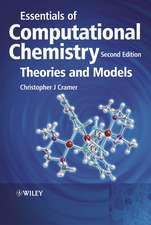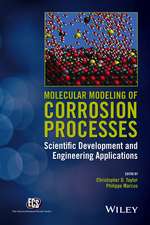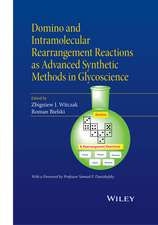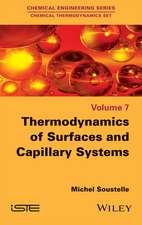Applications of Electronic Structure Theory: Modern Theoretical Chemistry, cartea 4
Editat de Henry Schaeferen Limba Engleză Paperback – feb 2014
Preț: 405.48 lei
Nou
Puncte Express: 608
Preț estimativ în valută:
77.61€ • 84.33$ • 65.24£
77.61€ • 84.33$ • 65.24£
Carte tipărită la comandă
Livrare economică 21 aprilie-05 mai
Preluare comenzi: 021 569.72.76
Specificații
ISBN-13: 9781468485431
ISBN-10: 1468485431
Pagini: 480
Ilustrații: XVI, 461 p. 49 illus.
Dimensiuni: 178 x 254 x 25 mm
Greutate: 0.83 kg
Ediția:Softcover reprint of the original 1st ed. 1977
Editura: Springer Us
Colecția Springer
Seria Modern Theoretical Chemistry
Locul publicării:New York, NY, United States
ISBN-10: 1468485431
Pagini: 480
Ilustrații: XVI, 461 p. 49 illus.
Dimensiuni: 178 x 254 x 25 mm
Greutate: 0.83 kg
Ediția:Softcover reprint of the original 1st ed. 1977
Editura: Springer Us
Colecția Springer
Seria Modern Theoretical Chemistry
Locul publicării:New York, NY, United States
Public țintă
ResearchCuprins
1. A Priori Geometry Predictions.- 1. Introduction.- 2. Equilibrium Geometries by Hartree-Fock Theory.- 3. Equilibrium Geometries with Correlation.- 4. Predictive Structures for Radicals and Cations.- 5. Conclusions.- References.- 2. Barriers to Rotation and Inversion.- 1. Introduction.- 2. Assessment of Computational Methods.- 3. Methods for Analyzing Rotational Barrier Mechanisms.- 4. Semiempirical Models.- References.- 3. Hydrogen Bonding and Donor-Acceptor Interactions.- 1 Introduction.- 2. Theoretical Methods.- 3. Observable Properties of Hydrogen-Bonded and Other Donor—Acceptor Complexes.- 4. Generalizations about the Hydrogen Bond.- 5. Summary.- References.- 4. Direct Use of the Gradient for Investigating Molecular Energy Surfaces.- 1. Gradient Method Versus Pointwise Calculations.- 2. Calculation of the Energy Gradient from SCF Wave Functions.- 3. Applications.- 4. Analytical Calculation of Higher Energy Derivatives.- References.- 5. Transition Metal Compounds.- 1. Introduction.- 2. The Technique of Ab Initio LCAO-MO-SCF Calculations.- 3. Bonding in Transition Metal Compounds.- 3.1. Bondingin “Classical” Complexes: CuCl42-.- 3.2. Bonding in Complexes of ?-Acceptor Ligands: Fe(CO)5.- 3.3. Bonding in Some Organometallics.- 4. The Concept of Orbital Energy and the Interpretation of Electronic and Photoelectron Spectra.- 5. Electronic Structure and Stereochemistry of Dioxygen Adducts of Cobalt-Schiff-Base Complexes.- References.- 6. Strained Organic Molecules.- 1. Introduction.- 2. The Nature of Strained Organic Molecules.- 3. Theoretical Methods for Strained Organic Systems.- 4. Discussion of Ab Initio Results.- 5. Summary.- References.- 7. Carbonium Ions: Structural and Energetic Investigations.- 1. Introduction.- 2. CH+.- 3. CH3+.- 4. CH5+.- 5. C2H+.- 6.C2H3+.- 7. C2H5+.- 8. C2H7+.- 9. C3H+.- 10. C3H3+.- 11. C3H5+.- 12. C3H7+.- 13. C4H5+.- 14. C4H7+.- 15. C4H9+.- 16. C5H5+.- 17. C6H7+.- 18. C7H7+.- 19. C8H9+.- 20. Conclusion.- References.- 8. Molecular Anions.- 1. Introduction.- 2. Background.- 3. Structural Studies.- 4. Heats of Reaction.- 5. Mechanistic Studies.- 6. Conclusions.- References.- 9. Electron Spectroscopy.- 1. Introduction.- 2. Studies of Valence Electrons.- 3. Studies of Core Electrons.- 4. Summary and Prospectus for the Future.- References.- 10. Molecular Fine Structure.- 1. Introduction.- 2. Theory.- 3. Computational Aspects.- 4. Numerical Studies of Fine Structure.- 5. Phenomena Related to Fine Structure.- 6. Conclusions.- Appendix. Vibration—Rotation Corrections to the ZFS Parameters.- References.- Author Index.







